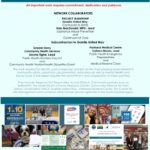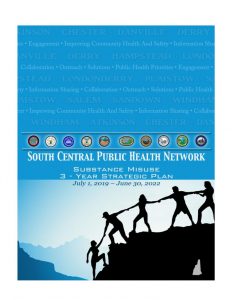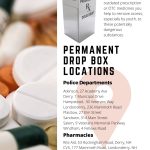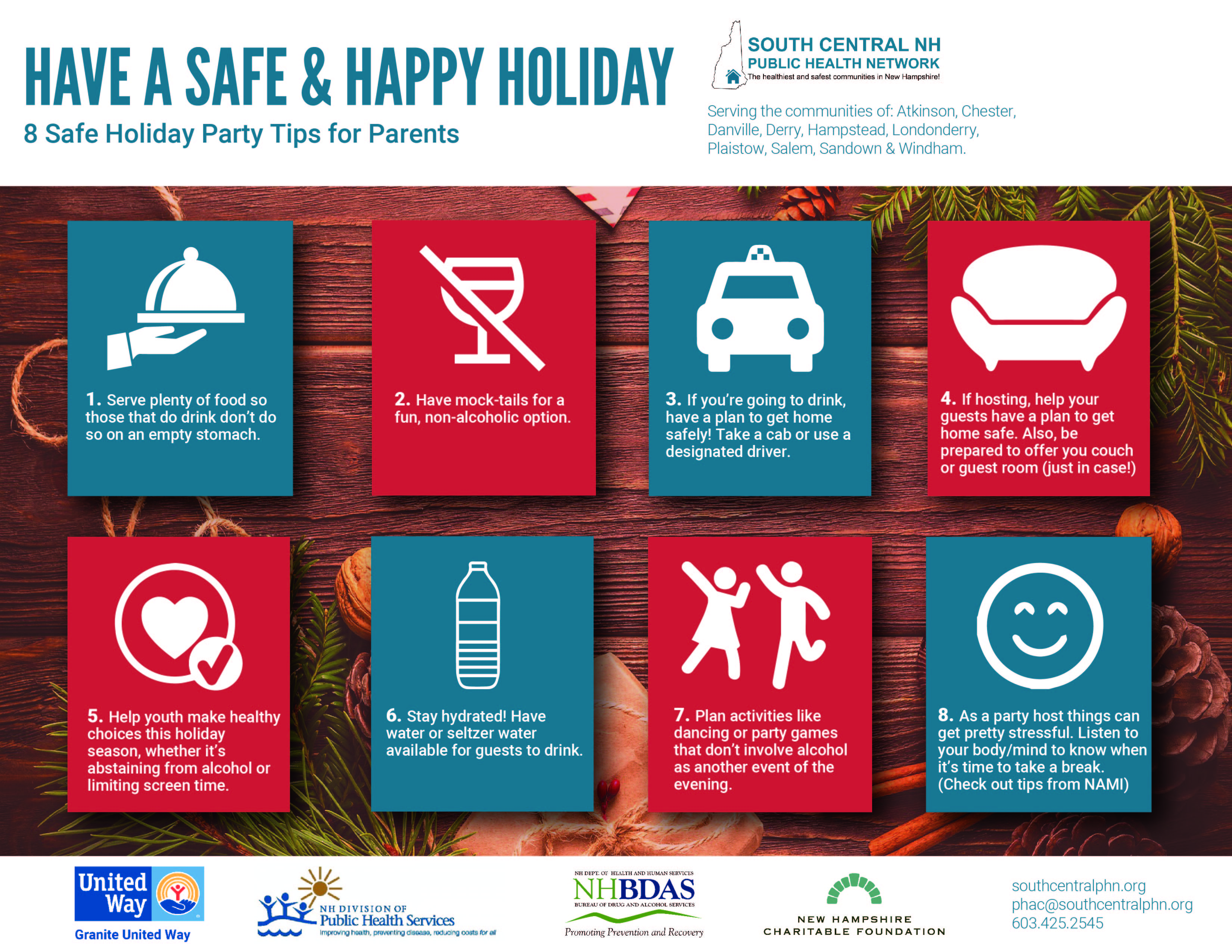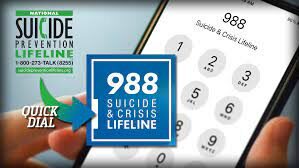Uncategorized
The Paths to Recovery – Treatment Defined, Part 2
What works best for you?
In our first post of this series, a broad overview of services available as you consider positive change was presented. It included counseling services: individual and group (aimed at readiness preparation and behavior change considerations). Groups were discussed including 12 step programs, as they are excellent to consider in conjunction with each counseling type and provide the peer-to-peer opportunity not found in a one on one setting.

Outpatient care is often a next step in treatment. Whatever path you choose, high quality outpatient support can make a huge difference in your journey.
Outpatient programs can vary from organization to organization depending on the intensity of the program. There is no hospital or facility stay. This is good for people with strong social supports already in place like close family or friends who support the desire to change and can have a positive influence on the process. In addition, it is sometimes helpful to have a member of your support network travel with you to appointments (when needed) or just be available to listen and be a sounding board for you before and after sessions. Outpatient care is less expensive than residential programs. Such programs are often able to address and treat co-occurring mental health disorders as well as the substance misuse issue. Many outpatient models use group counseling in their models as a part of the service menu.
Outpatient programs are the most popular type of treatment available in this region. There is Hampstead Hospital in Hampstead, Granite Recovery Center in Salem, Addiction Recovery Services in Salem, and Crossroads Recovery in Salem just to name a few. There is also Aware Recovery that is a statewide, in home recovery service. They are based in Bedford but they have a team that travels to different locations.
One size does not fit all, so take the time to speak with people at several facilities to see if you feel a connection at a particular program. Below are the links to the services mentioned above:
- Addiction Recovery Services: www.arsnh.com
- Crossroads: www.crossroadsrecoverycenter.com
- Granite Recovery: www.graniterecoverycenters.com
- Hampstead Hospital: www.hampsteadhospital.com
- Aware: www.awarerecoverycare.com
For information on a wide range of other treatment and recovery resources in the region, please take the time to look at the South Central Public Health Network Resource Guide for more information. https://southcentralphn.org/wp-content/uploads/2018/06/SCPHN-Resource-Guide.pdf
The Paths to Recovery – Treatment Defined, Part 1
Understanding your options for regaining your health and sobriety and be very stressful. It is hard to digest the vast amounts of information available to you.
Descriptions of treatment types can be confusing. One size does not fit all and the language of recovery may not always make sense to you. In this series of posts, we will discuss each type of service you might access if you are contemplating change or at a minimum are thinking about speaking with a professional about making a change.
Today we are introducing some first steps you might take when working towards change:
- Individual Counseling: A personal meeting with a professional who will speak with you about more than your use of substances. He or she will have a conversation with you about your living situation, strong or faltering relationships with family and friends, employment, legal history and your goals.

- Pursuit of Behavior Change: There are resources in the community to take advantage of if you are interesting in examining the path the led you to this place and looking at ways to change your patterns of behavior to support your desire to be substance free. There are experienced professionals ready to help through the following organizations:
- The Center for Life Management: 10 Tsienetto Rd in Derry and 103 Stiles Rd in Salem, www.centerforlifemanagement.org/
- Between Us Associates: 151 Main St in Salem, www.betweenusassociates.com/
- Bresnahan and Ball Counseling Services: 1B Commons Drive in Londonderry, www.bresnahanandballcounselingservices.com/
- Group Counseling: Group work is a very viable option and becoming more popular and effective for some people. Some example locations are:
- Addiction Recovery Services: 23 Stiles Rd in Salem, https://arsnh.com/
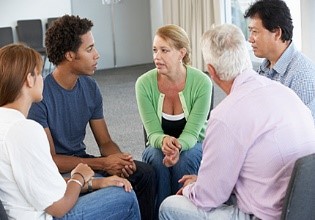
- Crossroads Recovery: 155 Main St in Salem, http://crossroadsrecoverycenter.com/
- Addiction Recovery Services: 23 Stiles Rd in Salem, https://arsnh.com/
- 12 Step Programs: Alcoholics Anonymous or Narcotics Anonymous are great services and they are present in almost every town in the state. For some, peer-to-peer support is critical in recovery. Sometimes alone or in combination with individual or group counseling 12 Step Programs play a critical and readily available supportive role in recovery. Some locations are:
- The Derry Friendship Center: 6 Railroad Ave in Derry, http://www.thederryfriendshipcenter.org/
- Granite Recovery Center: 6 Manor Parkway in Salem, https://www.graniterecoverycenters.com/pritts-recovery-center/
- To search for more check out www.nhaa.net
For information on a wide range of other treatment and recovery resources in the region, please take the time to look at the South Central Public Health Network Resource Guide for more information. https://southcentralphn.org/wp-content/uploads/2018/06/SCPHN-Resource-Guide.pdf
May is Lyme Disease Awareness Month!
May is Lyme Disease Awareness Month!
Lyme Disease Awareness Month may not be a reason to celebrate but it is a reason to take action! Lyme disease is a bacterial infection that is transmitted through the bite of an infected blacklegged tick. New Hampshire has one of the highest rates of Lyme disease in the nation. The best way to prevent getting Lyme disease is to take actions to avoid being bitten by a tick.
Prevention:
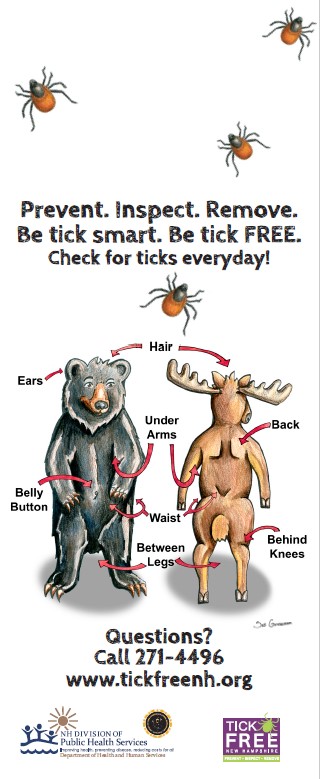
- Avoid wooded areas with a lot of brush and leaf litter. Stay in the center of a path when possible.
- Wear light colored clothing that will show ticks on you, preferably long sleeves, pants, and hat.
- Use insect repellent with at least 20% DEET or with oil of lemon eucalyptus. Use the Environmental Protection Agency (EPA)’s online tool to help you select the repellent that is best for you and your family: https://www.epa.gov/insect-repellents/find-repellent-right-you.
- Treat your clothes with permethrin (a non-staining insecticide used to repel and kill insects on clothing).
- Check yourself and your pet for ticks after being outdoors.
- Shower immediately after coming indoors and check ALL your body areas for ticks.
Tick Free NH developed this Shower Card to remind you to do a tick check every day. Tick Free NH is an initiative in New Hampshire that promotes tick awareness and provides information on preventing tick encounters. Go to their website at https://tickfreenh.org/to learn more about tick prevention, protection, and removal of ticks that can cause Lyme disease. You can also find educational materials for you to use and share with others.
Removal:
If you find a tick attached to you, don’t panic! According to the CDC, https://www.cdc.gov/lyme/removal
there are several tick removal devices available on the market, but a plain set of fine-tipped tweezers will remove a tick effectively.
How to remove a tick:
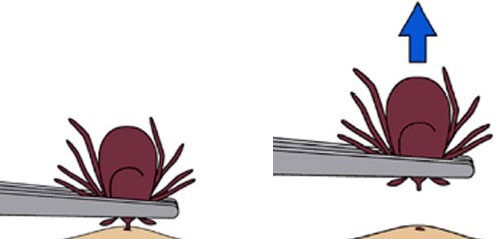
- Use fine-tipped tweezers to grasp the tick as close to the skin’s surface as possible.
- Pull upward with steady, even pressure. Don’t twist or jerk the tick; this can cause the mouth-parts to break off and remain in the skin. If this happens, remove the mouth-parts with tweezers. If you are unable to remove the mouth easily with clean tweezers, leave it alone and let the skin heal.
- After removing the tick, thoroughly clean the bite area and your hands with rubbing alcohol, an iodine scrub, or soap and water.
- Dispose of a live tick by submersing it in alcohol, placing it in a sealed bag/container, wrapping it tightly in tape, or flushing it down the toilet. Never crush a tick with your fingers.
Signs and Symptoms
Ticks can attach to any part of your body but are often found in hard-to-see areas such as the groin, armpits, and scalp. In most cases, the tick must be attached for 36 to 48 hours or longer before Lyme disease can be transmitted. The CDC lists the following early signs and symptoms that can occur 3 to 30 days after a tick bite: (https://www.cdc.gov/lyme/signs_symptoms)
Early Signs and Symptoms (3 to 30 days after tick bite)
- Fever, chills, headache, fatigue, muscle and joint aches, and swollen lymph nodes
- Erythema migrans (EM) rash:
- Occurs in approximately 70 to 80 percent of infected persons
- Begins at the site of a tick bite after a delay of 3 to 30 days (average is about 7 days)
- Expands gradually over a period of days reaching up to 12 inches or more (30 cm) across
- May feel warm to the touch but is rarely itchy or painful
- Sometimes clears as it enlarges, resulting in a target or “bull’s-eye” appearance
- May appear on any area of the body
It is very important to take precautions to avoid tick bites and take immediate action if you are bitten. By taking antibiotics for a few weeks, most people in the early stages of Lyme disease can be treated and will recover completely! (https://www.cdc.gov/lyme/treatment/index.html)If left untreated, the infection can spread to joints, the heart, and the nervous system, so contact your healthcare provider if you have any concerns about a tick bite. Did you know that Lyme disease can also affect your pets? Check your pets often for ticks to ensure that they stay healthy and that they are the only creatures that you are snuggling!
For more information go to: https://www.cdc.gov/lyme, https://www.dhhs.nh.gov/dphs/cdcs/lyme, & https://tickfreenh.org/
Stay safe, stay healthy, and stay tick-free!
Earth Day 2018: End Plastic Pollution
Earth Day is a global event occurring on April 22 of each year. With more than one billion people from 192 countries getting involved, Earth Day is the largest civic-focused day of action in the world (https://www.earthday.org/earthday). The Earth Day Network announced that the focus for Earth Day 2018 will be to End Plastic Pollution.
For many years, we have enjoyed the convenience of using plastics, but may not have been aware of the dangers to the ecosystem and our health. Air pollution, land pollution, and water pollution all impact the ecosystem and can directly and indirectly affect our health. Burning plastic releases chemicals into the air, causing air pollution and affecting the air we breathe. Breathing in too much of this polluted air can cause respiratory ailments. When plastics are dumped into landfills, they not only take up space, but degrade, which also releases chemicals. These chemicals seep into the soil, affecting the soil’s ability to sustain plant life and produce food. These chemicals can also flow into the groundwater, tainting the water that we drink.
Many of us have been to the beach and have seen another form of water pollution. Those random items you see in the sand or floating in the ocean impact the ecosystem. Plastics in the water can harm sea life by entangling them, choking them, or causing other health problems after ingesting. The sea life that consumes these plastics could be the one on your dinner plate. Now those plastic items you see bobbing up and down in the water may not look so innocent. They could be affecting your food, drinking water, and your health.

Garrett Simonsen, South Central NH Medical Reserve Corps Volunteer is dedicated to keeping the beach in his community clean. These are just some of the items he found while doing his part to remove plastics from our oceans.
How big is your Plastic Footprint? A Plastic Footprint is a way of measuring how much plastic you contribute to the worldwide trash pile. Reducing your plastic footprint benefits the ecosystem and decreases health risks for you, your family, and community. The Earth Day Network recommends taking five actions to reduce your plastic pollution footprint: Reduce, Refuse, Reuse, Recycle, and Remove!
REDUCE: Limit your use of plastics! Instead of buying bottled water, try a water filtering system. If you forgot to bring your reusable bags to the grocery store, ask for paper bags and try to buy in bulk. Consider bringing your own clean thermos to the coffee shop for that caffeine fix.
REFUSE: Go without a drinking straw when dining out (you could bring your own paper or reusable straw). Refuse the plastic bag from retail stores – bring your own or consolidate when making many purchases at the mall.
REUSE: Purchase items that can be used multiple times. Consider purchasing a reusable water bottle, thermos, canvas shopping bags, and glass food-storage containers.
RECYCLE: Place recycled items in a recycle bin and not the trash – if bins are not available, consider holding on to recyclable item until you find a bin. Follow your town’s rules on curbside recycling. Encourage your workplace to recycle.

Parkland Medical Center was awarded the Partner Recognition Award in Environmental Excellence from Practice Greenhealth. Parkland diverts 32% of total waste to recycling and promotes green practices throughout the hospital.
REMOVE: Keep your community clean! Join others in your area to remove litter from parks, beaches, schoolyards, and along the sides of roads when safe to do so! (Use gloves and pay attention to dangerous objects.)
By taking small steps today, you can reduce the size of your Plastic Footprint tomorrow!
To learn more about Earth Day initiatives and other ecosystem topics, go to: https://www.earthday.org, www.niehs.nih.gov/health/topics/agents/air-pollution, www.greenpeace.org/usa/10-genius-tips-reducing-plastic-footprint, www.theworldcounts.com/stories/Pollution-from-Plastic
Community Immunity
 Did you know that when you and your family are vaccinated, you are protecting not only yourselves, but your community as well? This is called Co
Did you know that when you and your family are vaccinated, you are protecting not only yourselves, but your community as well? This is called Co
mmunity Immunity! Community Immunity (also known as herd immunity) can decrease or even eliminate the spread of a disease in a community if a high percentage of the population has been vaccinated for a specific disease. 
Germs travel quickly through a community and can sicken many people, leading to an outbreak. If enough people are vaccinated against a certain disease, the germs cannot travel as easily from person to person – and the entire community is less likely to get the disease. Even some people who cannot get vaccinated will have some protection from getting sick because they will not be around as many people who are contagious. According to the U.S. Department of Health & Human Services, “if a person does get sick, there’s less chance of an outbreak because it’s harder for the disease to spread. Eventually, the disease becomes rare — and sometimes, it’s wiped out altogether.” https://www.vaccines.gov/basics/work/protection/index.html 
The Center for Disease Control and Prevention (CDC) states that vaccines lower your chance of spreading certain diseases and are one of the safest ways to protect your health and the health of those around you.
Keep you and your Community healthy and immune from preventable diseases! Don’t Wait. Vaccinate! https://www.cdc.gov/vaccines/hcp/adults/downloads/fs-three-reasons.pdf
Gardening with Youth
How Gardening with Youth Can Have a Positive Affect on Their Brain, Body, and Soul!

“We might think we are nurturing our garden, but of course it’s ours garden that is really nurturing us”
-Jenny Uglow
 Brain
Brain
When planting and tending to the garden with youth there are countless scientific concepts that you can discuss. Studies have shown that children who participated in gardening projects scored higher in science achievement than those who did not. The curiosity of watching a garden grow may even spark youth to ask questions like: Why do plants need sun?, How does a plant “drink” water?, Why are worms good for plants? You can also easily add a little math to gardening by measuring how much plants grow from week to week or counting the flowers on each plant.
Body
The act of gardening itself can promote a healthy body. Let’s face it, children love to get their hands and feet dirty. The hygiene hypothesis is a theory that says a lack of childhood exposure to germs actually increases a child’s susceptibility to diseases such as asthma, allergies, and autoimmune condition by suppressing the development of the immune system. Getting dirty while gardening may actually strengthen a child’s immune system overall health! The act of working in the garden has been shown to help youth stay calm and focused. It can also promote gross motor skills and overall strength with activities like pushing a wheel barrow, carrying a heavy water can, and using gardening tools to dig.
Soul
In the electronic age we live, youth need time for meaningful family connection that doesn’t involve screen time. Time spent in the garden allows for team building and can promote communication skills. Studies have shown that when children participate in activities such as digging and planting in soil can improve their overall mood, stimulate better learning experiences, and decrease feelings of anxiety.
For more information please visit: http://www.nationalgardenmonth.org/index.php?page=educators or https://www.betterhealth.vic.gov.au/health/healthyliving/gardening-for-children
Be an Advocate
Become an Advocate
Never doubt that a small group of thoughtful, committed citizens can change the world; indeed, it’s the only thing that ever has. – Margaret Mead
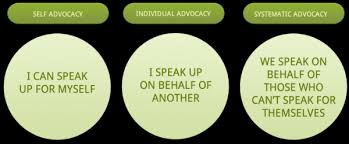
What is Advocacy?
Advocacy is defined as an action to speak in favor of, recommend, argue against or defend a position on behalf of oneself or others.
Have you ever heard of a policy with which you just do not agree? Have you wanted your voice to be heard when it comes to something that is being voted on in your state, but are not sure how to go about accomplishing that? Advocating for what you believe is your right and is not as complex as you may think. It can be as simple as writing a letter or an email to your District Representative or Senator or placing a call to their office. Advocacy happens concerning many issues. It may my conducted to support or oppose and issue such as the legalization of recreational marijuana, increasing the amount of low-cost sober living facilities in the area or increasing the amount of treatment and recovery options available in your region.
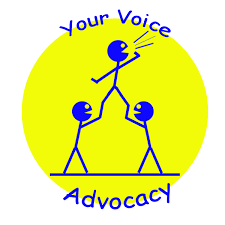 Advocacy is simply the act of letting your voice be heard. Every individual has the right to voice an opinion.
Advocacy is simply the act of letting your voice be heard. Every individual has the right to voice an opinion.
Here are three tips for contacting your representative or senator:
- Locate a mailing (email or physical address) for your legislative representative by using this link: http://www.gencourt.state.nh.us/house/members/wml.aspx
- Write a short letter in clear, concise and unemotional language describing your position on the issue. Sign the letter using your full name and the town in which you reside. If you hope for a response, include contact information.
- If you choose to contact by phone you may have to leave a message but always ask if it would be possible for them to return your call. Write down a few notes near your phone so that if you do receive a return call that you are prepared to speak.
- No matter how you choose to communicate, share a personal experience that you have had regarding the issue if possible. Explain why the experience has shaped your position and ask for their support.
There are several excellent resources in New Hampshire for learning more, building confidence and understanding how to conduct effective individual advocacy.
- NAMI-NH http://www.naminh.org/get-involved/advocate/take-action/its-your-move-advocacy-training/
- New Futures – http://www.new-futures.org/events/march-3rd-advocacy-training
- NH Children’s Trust – https://www.nhchildrenstrust.org/PATRochester18
- Parent Info Center of NH – https://www.picnh.org/
Have a Safe and Happy Holiday from The South Central Public Health Network
Keeping Your Home SAFE this Holiday Season
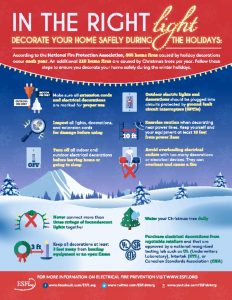 ‘Tis the Season to be jolly and Safe! Keeping you and your family safe this holiday season just takes a little extra time to be mindful when decorating. Safety should be first on your list when planning for the Holidays.
‘Tis the Season to be jolly and Safe! Keeping you and your family safe this holiday season just takes a little extra time to be mindful when decorating. Safety should be first on your list when planning for the Holidays.
Are you buying a Christmas tree this year? If so, whether you are searching for a Charlie Brown Christmas Tree or a Rockefeller Center Christmas Tree pay close attention to the needles before buying. Choose a tree with fresh green needles that do not fall off when touched. Dry trees are a fire hazard. After purchasing, cut 2 inches from the base of the trunk to allow the tree to absorb more water. Fill the tree stand with water and keep it filled. Remember to water it daily. According to the Old Farmer’s Almanac, a freshly cut tree can consume a gallon of water in 24 hours! Learn more at: https://www.almanac.com/content/how-care-christmas-tree.
When finding the perfect location to admire your tree in the home, you should always keep it 3 feet away from fireplaces, heating ducts, radiators, candles, or other heat sources. Do not put the tree in a place where it is blocking an exit or can be easily knocked over. Avoid tripping hazards by placing cords along the wall and away from doorways.
Are you wishing to make your home shine? According to the National Fire Protection Association, use lights that are listed by a qualified testing laboratory. Some lights are only for indoor or outdoor use. Inspect the string of lights for any worn or broken cords or loose bulb connections. Read the manufacturer’s instructions for the number of lights strands you can connect together. Do not overload extension cords. This could cause a fire or an electrical shock. Never use a real candle on or near your tree! Remember to turn off your lights before leaving the home or going to bed.
Once the holiday is over, remove the tree from your home before it gets dry. For more information on Christmas Tree Fire Safety go to: http://www.nfpa.org/News-and-Research/Resources/Emergency-Responders/Data-and-research/Fire-statistics-and-reports/Fire-statistics/Fire-causes/Holiday/Christmas-tree-and-holiday-lights.
May your Holiday Season be Merry, Bright, and Safe! To learn more about Holiday Decorating Safety, go to the Electrical Safety Foundation International (ESFI) website at: http://www.esfi.org/resource/holiday-decorating-safety.
Over the Counter Medication Recommendations in Cold and Flu Season
 Are you taking over the counter medications?
Are you taking over the counter medications?
Flu and cold season is officially underway! Are you properly taking your over the counter medications (OTC)? Did you know that one of the most commonly available pain-reliever and fever-reducer OTC medicines is Acetaminophen? It is found in Nyquil, Dayquil, Tylenol, Robitussin, Theraflu and many more. Taking too much can lead to serious complications such as acetaminophen induced liver toxicity.
This morning you had to stay home sick with a crummy cold or flu symptoms. You decided to start taking 2 extra strength Tylenol every 6 hours and Dayquil Cold & Flu every 4 hours. In order to help you get some sleep at night you also decided to take liquid Nyquil Cold & Flu.
Whoa now, take a step back! When taking all the above at recommended dosages every 4-6 hours you could be ingesting more than 5,000 mg of acetaminophen per day. This is above the Federal Drug Administration recommended maximum daily dosage of 4,000 mg. Taking dosages above the recommended daily amount could lead to overdoes, liver damage, and acute liver failure.
Read the labels! Many consumers are unaware of the risks associated with doubling or even tripling their OTC medication intake. Use caution! OTC Cold and Flu medicines may reduce some symptoms but will not help you get better faster. Be sure to consult your doctor or health care specialist before taking any medications.
For more information, visit www.KnowYourDose.org

